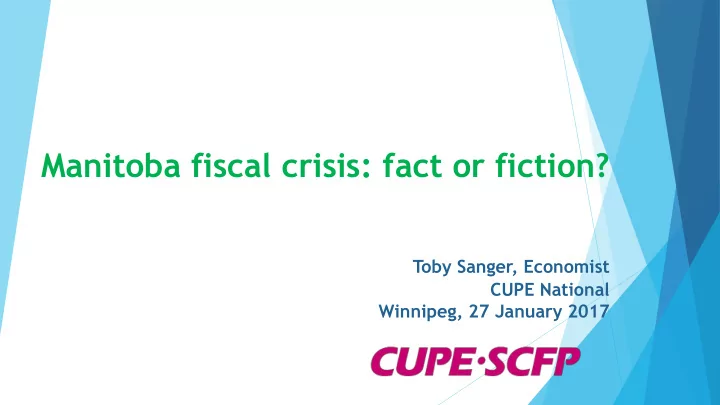

Manitoba fiscal crisis: fact or fiction? Toby Sanger, Economist CUPE National Winnipeg, 27 January 2017
Sudden Apocalyptic Deficit Syndrome Sudden Apocalyptic Deficit Syndrome
New Brunswick 2014 and 2015
Nova Scotia: Fall 2015 Oh my God!
But we can be saved….
Manitoba 2016/17
Manitoba’s deficit situation looks bad Manitoba Surplus/Deficit: record deficit in 2016/17 $800 $600 $400 $200 $0 $ millions -$200 -$400 -$600 -$800 -$1,000 -$1,200 Sources: Finance Canada Fiscal Reference Tables, Manitoba Finance * = projected
….but not that bad as share of economy Deficit as ratio of GDP/economy 2.0% 1.5% 1.0% 0.5% Surplus/deficit as share of GDP 0.0% -0.5% -1.0% -1.5% -2.0% -2.5% -3.0% -3.5% Source: RBC Fiscal Tables, December 20, 2016
Manitoba net debt/GDP at record Net Debt/ GDP -40.0% -35.0% -30.0% -25.0% -20.0% -15.0% -10.0% -5.0% 0.0% 1981-82 Source: RBC Fiscal Tables, December 20, 2016, * projected 1982-83 1983-84 1984-85 1985-86 1986-87 1987-88 1988-89 1989-90 1990-91 Manitoba Net Debt/GDP 1991-92 1992-93 1993-94 1994-95 1995-96 1996-97 1997-98 1998-99 1999-00 2000-01 2001-02 2002-03 2003-04 2004-05 2005-06 2006-07 2007-08 2008-09 2009-10 2010-11 2011-12 2012-13 2013-14 2014-15 2015-16 2016-17*
..but cost of paying for debt at record low Manitoba debt Interest/GDP at record low 2.50% 2.00% 2.07% 1.99% 1.87% 1.73% 1.70% 1.50% 1.59% 1.49% 1.45% 1.45% 1.41% 1.32% 1.31% 1.30% 1.28% 1.00% 0.50% 0.00% 2003-04 2004-05 2005-06 2006-07 2007-08 2008-09 2009-10 2010-11 2011-12 2012-13 2013-14 2014-15 2016-17 2015-16 Sources: Finance Canada Fiscal Reference Tables, RBC Fiscal Tables. Figures pre-2003 not comparable.
Is MB gov’t spending “unsustainable”? Total average annual spending growth 2012/3 to 2015/16 = 3.4% Total average annual revenue growth 2012/3 to 2015/16 = 3.4% As long as revenues increase at same or faster rate as total spending, then spending is sustainable Best indicator for future revenue growth is growth of economy, nominal GDP
Manitoba economy to grow faster than government spending Manitoba Nominal GDP Forecasts 2017 2018 2019 2020 2021 2022 2023 Average Manitoba Finance (Dec 16) 3.9% 3.9% RBC Economics (Dec 16) 4.4% 4.4% 4.4% TD Economics (Dec 16) 3.2% 3.6% 3.4% CIBC Economics (Nov 16) 3.5% 4.0% 3.7% Scotiabank (Jan 16) 3.6% 3.5% 3.6% Conference Board (Nov 16) 4.1% 3.3% 3.5% 3.6% 4.0% 4.0% 3.6% 3.7% Average 3.8% 3.8% 3.5% 3.6% 4.0% 4.0% 3.6% 3.9%
Status quo baseline leads to declining deficits, but not balance within eight years Manitoba Basic Fiscal Forecast, spending growth at 3.4% annually (in millions) 2016 2017 2018 2019 2020 2021 2022 2023 Total revenue $15,432 $16,032 $16,635 $17,222 $17,847 $18,565 $19,308 $20,005 Total spending (at 3.4% p.a.) $16,436 $16,995 $17,573 $18,170 $18,788 $19,427 $20,087 $20,770 Deficit ($1,004) ($963) ($938) ($948) ($940) ($862) ($779) ($765) Deficit/GDP ratio -1.5% -1.4% -1.3% -1.2% -1.2% -1.0% -0.9% -0.9% Revenue grows at forecasted rate of nominal GDP growth
Can achieve balanced budget within eight years with slightly slower spending growth Manitoba Basic Fiscal Forecast, spending growth at 2.8% annually (in millions) 2016 2017 2018 2019 2020 2021 2022 2023 Total revenue $15,432 $16,032 $16,635 $17,222 $17,847 $18,565 $19,308 $20,005 Total spending (at 2.8 % p.a.) $16,436 $16,896 $17,369 $17,856 $18,356 $18,870 $19,398 $19,941 Deficit/ Surplus ($1,004) ($864) ($734) ($634) ($508) ($305) ($90) $64 Deficit/GDP ratio -1.5% -1.2% -1.0% -0.8% -0.6% -0.4% -0.1% 0.1% Revenue grows at forecasted rate of nominal GDP growth
Could achieve balanced budget immediately with revenues similar to average of last 10 years Manitoba Basic Fiscal Forecast, spending growth at 3.4%, revenues at 24% of GDP (in millions) 2016 2017 2018 2019 2020 2021 2022 2023 Revenues at 24% of GDP $16,454 $17,094 $17,737 $18,363 $19,030 $19,795 $20,587 $21,331 Total spending (at 3.4% p.a.) $16,436 $16,995 $17,573 $18,170 $18,788 $19,427 $20,087 $20,770 Balance (surplus) $18 $99 $165 $193 $242 $368 $500 $561 Surpluses over eight years = over $2 billion .
Potential revenues from federal measures Carbon tax = $130 million @ $10/tonne and $650 million @ $50/tonne Closing capital gains and stock option deduction = $100 million+ Revenues from marijuana legalization = $25 million plus Total from these three = $775 million + Enough to eliminate deficit w/in eight years
Public spending provides stronger economic impact than tax cuts
Manitoba economy solid and diversified Most forecasters expect MB economy to be one of top provincial performers in 2017 and 2018 Unemployment rate still 2 nd lowest in Canada, has risen: gov’t needs to focus on maintaining & creating jobs Economy is diversified and expected to benefit from U.S. growth Solid population growth Wage and income growth stronger than national average Household debt ratios one of lowest
Summary Politicians sometimes exaggerate how bad their fiscal situation is to get support for cuts to public sector wages and spending, so they then have $$ to spend before next election – but can backfire Manitoba has some fiscal challenges, but it certainly isn’t a crisis Current situation is fiscally sustainable with economic growth, but wouldn’t result in balanced budgets for at least a decade Could balance budget with slightly slower spending growth and/or higher revenues Cuts to public spending have a worse economic impact than tax increases Fiscal health dependent on economic growth
Recommend
More recommend